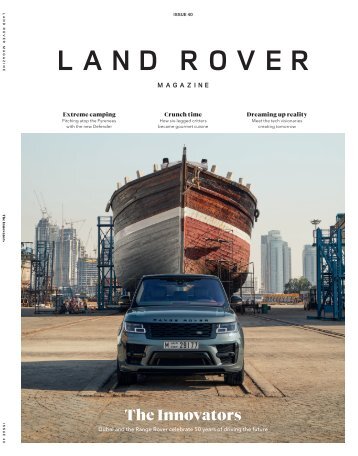38 As a grinder, Ed
38 As a grinder, Ed Powys needs both physical strength and endurance. His task: to help pump power into the hydraulic system to maximise the crew’s control when manoeuvring on the water
TEAM BUILDING 12-15 HOURS PHYSICAL TRAINING PER WEEK 24-40 YEARS SQUAD AGE RANGE Your biceps, your forearms, are screaming for mercy. As you push to keep turning those brutal handles on the unyielding grinding pedestal, you allow yourself the briefest of glances across at your opponent. You try to remind yourself that they’re hurting just as much as you are. Suddenly the dreadnought bows of their foiling, carbon-fibre catamaran drop down and spear into the Bermudian waters in twin plumes of blue and white spray. From 40 knots to zero in a second, and your rival’s unexpected moment of crash-and-burn has earned your muscles the briefest of reprieves. In such moments will the 35th America’s Cup be decided this summer on the azure blue waters of Bermuda, the small tropical island situated more than 600 miles off the USA’s Atlantic coastline. ‘The America’s Cup’ is the most prized trophy in the sailing world, one that has attracted Sir Ben Ainslie to pit his wits and his team at Land Rover BAR against five other strong international crews this May and June. Sailing has mostly been a thinking man’s sport, where mental agility trumps physical fitness. But the modern America’s Cup places a huge emphasis on physical fitness like never before. Over the 166-year history of the Cup, there’s always been a need for immensely strong sailors to turn the winches to pull in the enormous sails and manoeuvre the boat more quickly and efficiently than their rivals. But up to 2007, the event used to take place in heavy keelboats on long courses where races could last more than an hour and there might be more than a five-minute break between each manoeuvre. Strength was useful, cardiovascular fitness less so. In the past five years, however, this has changed profoundly. The keelboats have given way to light-weight carbon-fibre catamarans that hydrofoil above the surface, racing around much smaller, tighter courses. These ‘foiling’ America’s Cup Class multihulls don’t fly themselves though. They’re inherently unstable beasts and, left to their own devices, would career out of control in a matter of seconds. Above the water is the 24m-tall wing mast that captures the wind and provides the power. Below the surface are some precision-built slick hydrofoils, sometimes referred to as ‘dagger foils’. Both the control of the wing and the hydrofoils require hydraulic power, and the only engine to power up the hydraulic systems is what the four ‘grinders’ can provide through sheer muscle power and cardiovascular fitness. The key to winning races in Bermuda this summer will be for the crew to achieve continuous stable ‘flight’ from the start to the finish some 15 to 20 minutes later. Keeping these 50ft catamarans flying in a straight line is hard enough, and then you’ve got the manoeuvres, the tacks (a 90-degree turn heading into the wind) and the gybes (a 90-degree turn with the wind behind you), when there are simply too many tasks for the six-man crew to manage everything effectively. But the more power the athletes can pump into the hydraulic system, the more control they will ultimately have over the success of these manoeuvres. More control = more speed. If the rules didn’t forbid it, these America’s Cup Class catamarans would be equipped with state-ofthe-art, fly-by-wire electronics of the kind seen in a modern military jet like the Eurofighter. Stable flight would then become a digital doddle. But without the electronic aids, it’s down to the mental and physical skills of the six sailors (one helmsman, one wing-sail trimmer and four grinders) to get the boat around the course as best they can. So the limiting factor in the system really is the physical output that the sailors can push through the handles. On the waters of today’s America’s Cup, being in shape makes all the difference between glory or potential defeat. The person tasked with making that weakest link as strong as possible is Ben Williams, who comes to sailing from a military background and a passion for ultra-endurance sports such as competing in the Marathon des Sables across the Sahara Desert. Williams has built the bespoke Land Rover BAR training programme from the ground up, and it’s no walk in the park. “When I looked at the old-style racing in keelboats, there was a 1:6 work-to-rest ratio, whereas now it’s more like 6:1. It’s full-on pretty much from the start of the race to the finish,” he says. Thanks to his programme, week by week the Land Rover BAR team is getting better and better at 39













